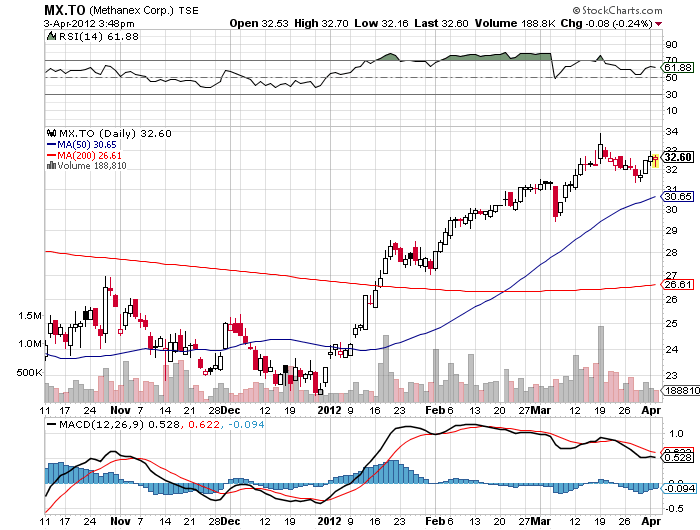Energy & Commodities
There are many instances when an energy exchange-traded fund (ETF) and exchange-traded notes (ETNs) can come in handy…
You can use them to play commodities like oil and natural gas without actually buying commodity contracts.
You can use them to play individual sectors without having to put all your chips on one company.
And you can use them to hedge against macroeconomic events like inflation and bear markets by quickly going short without actually shorting.
The selection of energy ETFs available seems to grow every week, so here’s a partial rundown of your options and when to use them.
Energy Commodity ETFs and ETNs
-
PowerShares DB Energy (NYSE: DBE) – Splits its assets between West Texas Intermediate (WTI) crude, gasoline, Brent crude, heating oil, and natural gas
-
iPath S&P GSCI Crude Oil (NYSE: OIL) – Tracks the return of WTI
-
iPath Dow Jones-UBS Commodity Sub-index Total Return (NYSE: JJE) – Tracks the return of crude oil, heating oil, natural gas, and unleaded gasoline
-
United States Gasoline (NYSE: UGA) – Tracks the movement of gasoline prices
-
United State Natural Gas (NYSE: UNG) – Tracks the return of natural gas futures
Short Energy Commodity ETFs and ETNs
-
PowerShares DB Crude Oil Short (NYSE: SZO) – Short oil
-
United States Short Oil (NYSE: DNO) – Short oil
-
ProShares UltraShort DJ-UBS Natural Gas (NYSE: KOLD) – Short natural gas
Broad-based Energy ETFs and ETNs
-
Market Vectors Oil Services (NYSE: OIH) – Basket of behind-the-scenes oil companies like Schlumberger (NYSE: SLB), Baker Hughes (NYSE: BHI), and Transocean (NYSE: RIG)
-
Energy Select Sector SPDR (NYSE: XLE) – Basket of oil majors and drillers like Exxon (NYSE: XOM), Chevron (NYSE: CVX), Anadarko (NYSE: APC)
-
iShares S&P Global Energy (NYSE: IXC) – Basket of international oil companies like Total (NYSE: TOT), BP (NYSE: BP), and Royal Dutch Shell (NYSE: RDS)
-
PowerShares Global Clean Energy (NYSE: PBD) – Basket of international solar, wind, geothermal, and grid players
-
First Trust Global Wind Energy (NYSE: FAN) – Basket of international wind players
-
Guggenheim Solar (NYSE: TAN) – Basket of international solar players
-
iShares S&P Global Nuclear Energy (NASDAQ: NUCL) – Basket of nuclear operators and uranium players like Exelon (NYSE: EXC) and Cameco (NYSE: CCJ)
-
Market Vectors Coal (NYSE: KOL) – Basket of international coal miners and sellers like Peabody (NYSE: BTU) and China Coal Energy
-
First Trust NASDAQ Smart Grid (NASDAQ: GRID) – Basket of grid operators and electricity infrastructure companies like ABB (NYSE: ABB) and NGK Insulators
-
EGShares Energy GEMS (NYSE: OGEM) – Basket of emerging market energy companies ranging from Petroleo Brasileiro (NYSE: PBR) to Renesola (NYSE: SOL)
Leveraged Energy ETFs and ETNs
How to Use Them
That list could easily be twice that size, because so many brands offer the same thing…
Among ProShares, PowerShares, iPath, Direxion, and Market Vectors, you’re bound to find duplicate offerings for the same sector or investment strategy.
Brand doesn’t really matter to me; I’m more interested in the funds’ objective.
For example, in the annual run-up of oil and gas prices in spring and summer, I’m usually in a long oil or gasoline fund.
If corporate earnings are bad or other signs of recession are popping up, you can get on the short side to capitalize on the commodity sell-off that always follows bearish macro news…
Or you can use them to play Fed announcements and other economic factors.
Commodities usually rise during inflationary periods, so use an ETF to get long commodities the next time Ben says he’s printing more money.
I love ETFs because they can be used to play like a hedge fund manager without having to get your hands dirty in actual commodities contracts or the physical shorting of stocks.
In other words, they allow you to act on ideas and deploy complex strategies usually reserved for the Wall Street elite… just by buying a single security.
Use them often to diversify your energy investment approach and increase your success.
Call it like you see it,
![]()
Nick Hodge
Editor, Energy and Capital
P.S. Besides energy ETFs, Angel Publishing owner Brian Hicks has found another way to invest like a Wall Street higher-up… There’s an investment you can make that allows you to collect rent from Wal-Mart, the world’s largest retailer and third-largest employer. It’s very real and very legal, and you can start collecting your share today.
-
ProShares Ultra DJ-UBS Crude Oil (NYSE: UCO) – Twice the daily return of oil
-
ProShares UltraShort DJ-UBS Crude Oil (NYSE: SCO) – Negative 2x the daily return of oil
-
ProShares UltraShort DJ-UBS Natural Gas (NYSE: KOLD) Negative 2x the daily return of natural gas
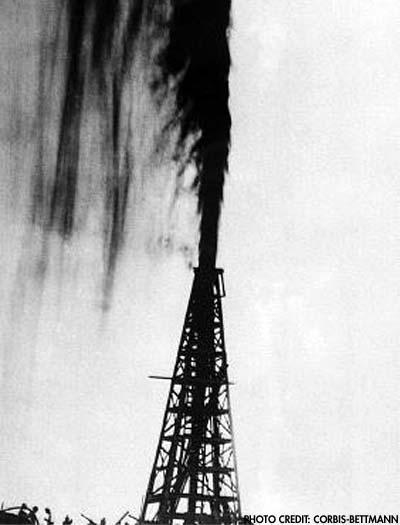

Examining the macro-economic environment is how Jim Letourneau, publisher of the Big Picture Speculator, likes to begin his stock-picking process. However, his understanding goes beyond headline news to reveal surprising investment themes with profit potential. In this exclusive interview, Letourneau talks about the hype and commodity investment cycles and where to dig for blue-sky stocks.
COMPANIES MENTIONED: BIOASIS TECHNOLOGIES – DNI METALS INC. – ENERGY FUELS INC. – METHANEX CORP. – TALVIVAARA MINING CO. PLC. – UR-ENERGY INC. – URANERZ ENERGY CORP. – URANIUM ENERGY CORP. –
The Energy Report: You publish the Big Picture Speculator. What does that title imply?
Jim Letourneau: I believe the macro context is often more important than the details about an individual company. I read a broad range of material every day that helps me form my views, and one of my best skills is putting together the big picture and connecting the dots for audiences. A recent example of my method is my coverage of the natural gas sector, which focused on how the abundant supply of natural gas has led to a complete shift in the types of companies that people should be following. Rather than natural gas producers, investors should find companies that are consuming natural gas, like Methanex Corp. (MEOH:NASDAQ; MX:TSX; METHANEX:SSE)
Westport Innovations Inc. (WPT:TSX)
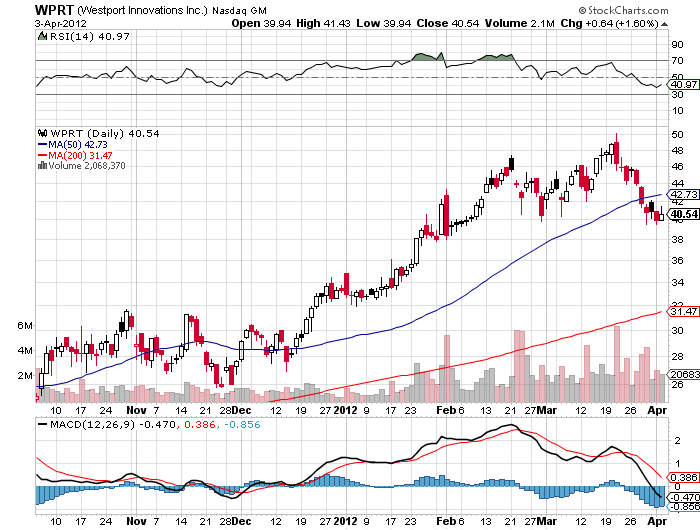
or Energy Fuels Inc. (EFR:TSX). These companies are in great shape because their costs are significantly lower. That’s a huge big-picture shift, but people get bogged down in all of the debates about fracking and other controversies.
The bottom line is the U.S. now has the cheapest natural gas in the world, and that’s not a horrible problem to have. When I talk to technical people, we just look at each other and think this is a miracle. No one saw this coming.
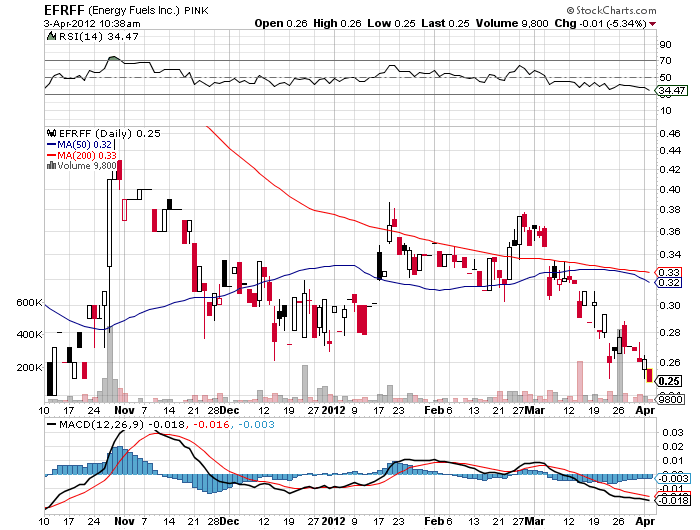
TER: As a geologist, how does your technical knowledge shape your investment decisions? What do you look for in potential investment opportunities?
JL: Technical knowledge includes pluses and minuses. In general, the types of companies I look for are usually going to have a market cap of under $100 million (M) and for me to get excited about them, they have to have the potential to surmount that $1 billion (B) market cap. So there’s a potential tenbagger upside in them, if everything pans out. That potential could be in the form of a new technology backed by a critical management team or a higher-quality mineral property. Either way, management teams are critical for these types of things to play out.
TER: How far down in market cap do you go when considering investments?
JL: Sometimes I go down too far, but I think $50M is better than $5M. While you can argue that it’s easier for a $5M market-cap company to go to $50M, your odds start to dwindle. It’s a matter of finding that balance point. Obviously, it’s nicer to buy a company cheap and have it grow into something bigger, but the company is usually cheap for a reason. I don’t want to have to write about 50 companies a year that didn’t quite make it. I’d rather go up the food chain a little bit and follow ones that are going to survive, and whose progress we can track year by year.
TER: You spoke at the Cambridge House Energy and Resource Investment Conference in Calgary on March 30 and 31. What subjects did you cover?
JL: My keynote talk was called “Making Money Using Commodity and Hype Cycles.” I overlayed two kinds of cycles: The commodity cycle is a longer cycle that we’ve been in for over 10 years now. Hype cycles refer to heightened public awareness of a new technology or a particular element on the periodic table that hasn’t been speculated on yet. A recent example would be graphite. Uranium is another really good example of a hype cycle; there was a huge amount of interest about eight years ago and hundreds of companies were formed. Investors were making lots of money with uranium stocks. Then it all withered away. There is still opportunity because some of those companies are still around and advancing their businesses.
I also did a workshop called “How to Find Billion-Dollar Companies,” where I mentioned some of the companies I like that have market caps near $100M with the blue-sky potential to get up to the $1B level.
TER: What do you think the potential is on a percentage-wise basis of finding billion-dollar companies?
JL: The odds are challenging. This is more speculative and it’s much higher risk than a nice dividend-paying stock with cash flow. These companies have lower market caps for a reason; there is either skepticism about the technology or a lot of competition. We don’t need 100 new rare earth mines, but maybe we have 100 rare earth companies. So which companies are going to win that race? It’s a bit like horse racing; you pick your favorites. The odds are you’re not going to win on every one of them.
TER: For a company to get to a $1B market cap these days is probably going to involve some acquisitions and consolidations, unless it really has some amazing property or technology.
JL: That’s very true. Sometimes companies just lay it out and if you can see that it can get the sales and the trajectory, it is certainly possible, and it does happen. It’s a challenge, and that’s what we’re looking for.
The other important part of the stock-picking process is the timeframe. The commodity cycle has a long-term timeframe, whereas the hype cycles can be pretty brief. Eventually, the market turns and the interest goes away. The challenge for these companies, if they have something real, is to keep moving the project forward until the next hype cycle comes around, when people get really interested again. If you’re investing in equities related to commodities, you’re speculating both in the market and on commodities. Sometimes you can have the right commodity, but the company you pick doesn’t follow that commodity’s price performance very well.
TER: Can you point to any companies you’ve seen in the last few years that have turned out that way?
JL: There are a few. To be honest, the other part of this strategy is that for every company that I talk about and like, there are probably 100 that I don’t. There’s a lot of screening and filtering to get rid of the ones that don’t have the potential. One company that I like right now is a biotech that I think we’re at a triple on right now called biOasis Technologies Inc. (BTI:TSX.V). It has a protein that can cross the blood-brain barrier. Therapeutic molecules can be conjugated to this protein, allowing it to cross the blood-brain barrier. This can dramatically increase an existing drug’s effectiveness. That’s one. We found it under $0.50, and now it’s in the $1.40–1.50 range.

DNI Metals Inc. (DNI:TSX.V; DG7:FSE) has also performed really well. While it’s down now, it had gone from around $0.20 to more than $0.60. I like it because it’s pushing the frontiers a little bit. It has a very large, black shale metal deposit in northeastern Alberta, a bit north of the oil sands. Historically, very few geologists studied shales, but they’ve become more popular now because of shale oil and gas. The Alberta Geological Survey has done numerous studies going back to the early 1990s that mention an anomalous metal content in the Second White Speckled Shale. The grades are really low, but the deposits are very extensive. There are huge resources in place containing a whole cocktail of meterials, including rare earths, nickel, iron, vanadium, uranium, zinc, copper, cobalt and molybdenum. It’s almost a conceptual play in some ways. Although the grades are not stellar, they are a little bit higher than we’d expect anywhere else.
So it’s a resource-in-place story, but it’s also a technology story because we’ve seen other industries dealing with a low-grade resource that suddenly become economic plays because of technological breakthroughs. The best example of that is probably shale gas, where people knew for a long time that there was gas in these shales, but nobody was really making any money from them. New technology comes along, and suddenly these shale deposits are worth a lot of money.
For DNI Metals, the challenge is how to get the metals out and make money doing it. The best method to extract these metals is pointing to a technology called bioleaching, which is being used by a company called Talvivaara Mining Co. Plc. (TALV:LSE) in Finland. That’s the exciting part that’s pushing the frontiers.

TER: Are these metals pretty much disseminated throughout this whole deposit, or are certain metals concentrated in certain areas?
JL: The metals are widely disseminated within a fairly uniform and consistent material. That makes it similar to coal or potash mining, where the ore bodies are tabular in shape. They may not be exciting, but at least you know what to expect and you can plan very large operations around that.
TER: With bioleaching, is in situ recovery (ISR) an option?
JL: There may be some way to use ISR, but the bioleaching at Talvivaara involves actually digging it up, piling it onto pads and leaching it by letting the bugs do their work and make acid. But there may be a way to apply in-situ technology in the upper zone. Bioleaching in heaps seems to be the approach with the most potential at the moment.
The value of the minerals in this shale is probably $40 per ton (/t). Extracting the metals for less than $30/t is the challenge. No one’s done it before, so there’s a lot of skepticism. I think a really big mining company would eventually take interest in this because it’s the kind of project that, if it can get up and running, has a life-of-mine potential of over 100 years.
TER: You mentioned uranium earlier. Despite Fukushima, people are realizing that nuclear is here to stay and one of our best sources of energy generation for the foreseeable future. Is there still life after its hype cycle has ended?
JL: I think uranium’s future is very bright and it is a critical part of the world’s energy matrix. We can’t really afford to just turn it off. There actually are a lot of benefits to using it. In terms of the actual price of uranium, the market may not be as excited about it yet, but Russia said it will not renew its supply agreement with the U.S. so analysts are anticipating shortages starting in 2013, which isn’t that far away.
TER: What other companies would you like to comment on?
JL: I like the uranium companies that use ISR technology. The main plays I’ve been considering are either in Wyoming or Texas, where you don’t get the really high grades that you find in the Athabasca Basin. There were hundreds of uranium explorers in the Athabasca Basin and the only one that’s really been successful for investors was Hathor Exploration Ltd., which was recently acquired by Cameco Corp. (CCO:TSX; CCJ:NYSE). With an ISR uranium project, you have a degree of certainty that a company will actually be able to build the mine and get it into production.
There are three companies in that space that I like. Going from the smallest market cap to the biggest, there is Ur-Energy Inc. (URE:TSX; URG:NYSE.A), in Wyoming. It’s on track to be a producer very soon with expected permitting for its Lost Creek mine early this summer. Then it will be able to get its mine into production probably within six months.

Uranerz Energy Corp. (URZ:TSX; URZ:NYSE.A) is a similar company in Wyoming. It has actually started its mine construction and is looking to start producing 600–800 thousand pounds (Klb) uranium/year very shortly. Both are very near-term production stories.
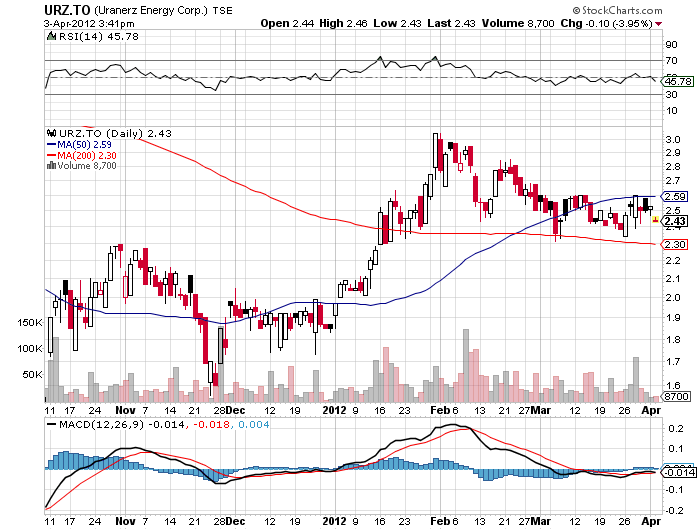
The last one, Uranium Energy Corp. (UEC:NYSE.A), is currently producing in Texas. It has an inventory of projects coming online and the company announced property acquisitions in Paraguay and Arizona earlier this year. These are all companies with uranium resources that, once their facilities are built, enable extremely long production runs. Typically, they’ll have a centralized uranium processing plant and all of the mines around it will be satellite projects.
The challenge for all of these companies has been permitting. The various U.S. government regulatory bodies didn’t really have anyone qualified to evaluate ISR projects because there haven’t been any new ones developed for decades. The absence of a competent regulatory structure has slowed down progress on getting these mines built. These companies have typically spent a year or two longer than they expected on the regulatory process; it’s not a reflection of any gaps in the quality of their projects.
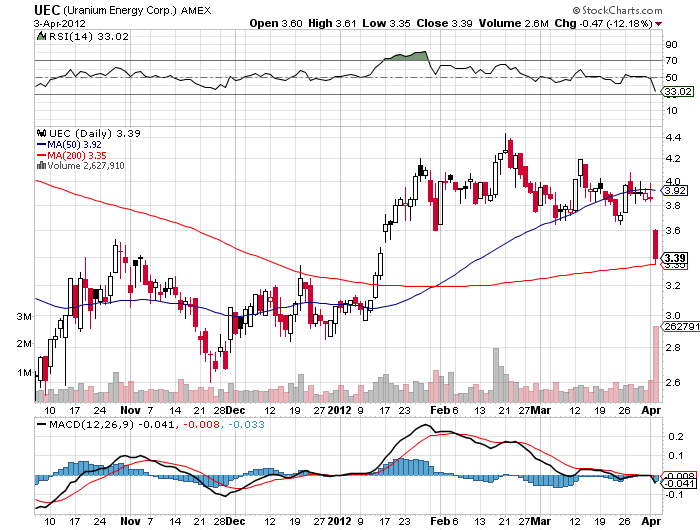
TER: At least the regulators are willing to permit these operations, which apparently was quite a problem for a while.
JL: That’s a very good point. These are viable, useful industries with quite good safety records and low environmental impact. Again, I like to talk about the big picture.
TER: What sort of capital costs do these uranium ISR projects have?
JL: There’s a range, but the costs are usually $20–30/lb. But these companies are pretty comfortable that they can eke out a living at the current uranium price, which is not going to encourage a whole bunch of new projects to come along. They’re anticipating higher longer-term prices, which should make them quite profitable.
TER: Do you have any thoughts on the current gold market?
JL: I just tell people to look at a 12-year gold chart. Gold is probably the best-performing investment product over that timeframe. I personally don’t think gold has that critical a role in the monetary supply, but it is a place to preserve wealth and look for protection. This recent consolidation pullback is probably an opportunity, but people need to remember that bull markets don’t last forever. However, gold still has legs right now, and the trend is your friend.
TER: Looking at the “big picture,” what do you suggest people do to figure out how they should invest their money these days?
JL: Investors have to do their research and be informed. We are in dangerous times. A lot of assets are correlated so it’s hard to find safety. Sometimes maybe the best safety is not even being in the market, which I hate to say. I like finding good companies that are going to grow into viable businesses. But the markets are not kind, and we’ve seen what can happen when the flow of capital gets turned off. The valuations of publicly traded companies, big and small, in all sectors, tend to drop in unison, even precious metals prices. It’s important to be mindful of the downside. I look for upside opportunities because I’m an optimist and I assume that life will go on.
We do have some structural issues in the financial system. If that breaks down, you really don’t want to own anything that’s not tangible. That’s the strongest investment thesis for owning hard assets. That doesn’t mean owning shares in a hard asset company; that means owning the physical hard asset. If you own a car, a house or some gold, those things will still be around no matter what happens to the money supply and currency valuations. The monetary system is a wild card, and that’s the thing that keeps everybody nervous. We can make informed guesses, but nobody really knows how that’s going to play out.
TER: We appreciate your time and input today.
JL: My pleasure.
Jim Letourneau is the founder and editor of the Big Picture Speculator and is a professional registered geologist living in Calgary, Alberta. He has over 20 years of experience in the oil and gas sector.
Want to read more exclusive Energy Report interviews like this? Sign up for our free e-newsletter, and you’ll learn when new articles have been published. To see a list of recent interviews with industry analysts and commentators, visit our Exclusive Interviews page.

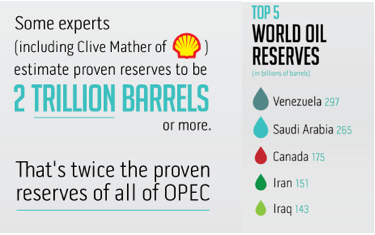
Canada is sitting on an Ocean of money. 2 Trillion Barrels of Oil! is a massively more than our current status 175 Billion Barrels proven, which now ranks us #3 in the World after Venezuala & Saudi Arabia. Let this visual story (main chart below) convince you of the Massive Wealth, practically unimaginable change, opportunity & Prosperous Future in the offing. 2 Trillion is more than twice the entire reserves of OPEC. Bottom line, Canada’s Developing Oil Wealth combined with hungry customers like China & the easy to ship to US…….makes the Shieks of the Middle East begin to look like homeless paupers by comparison.
To realize this wealth, all Canada has to do is clean up the Worlds largest Natural Oil Spill.
For Larger Image Click HERE or on the image itself below:

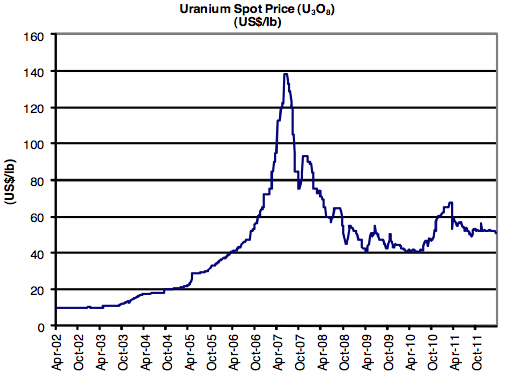
Resource Capital Research covers 9 exploration, development and production companies in this report. It is over 12 months since the Fukashima accident & the impact has been factored in. The market is expected to be broadly

Canada #1 In Oil Reserves in The World – Amazing Graphics Showing 2 Trillion Barrels Of OilSands Oil

Canada is sitting on an Ocean of money. 2 Trillion Barrels of Oil! is a massively more than our current status 175 Billion Barrels proven, which now ranks us #3 in the World after Venezuala & Saudi Arabia. Let this visual story (main chart below) convince you of the Massive Wealth, practically unimaginable change, opportunity & Prosperous Future in the offing. 2 Trillion is more than twice the entire reserves of OPEC. Bottom line, Canada’s Developing Oil Wealth combined with hungry customers like China & the easy to ship to US…….makes the Shieks of the Middle East begin to look like homeless paupers by comparison.
To realize this wealth, all Canada has to do is clean up the Worlds largest Natural Oil Spill.
For Larger Image Click HERE or on the image itself below:


